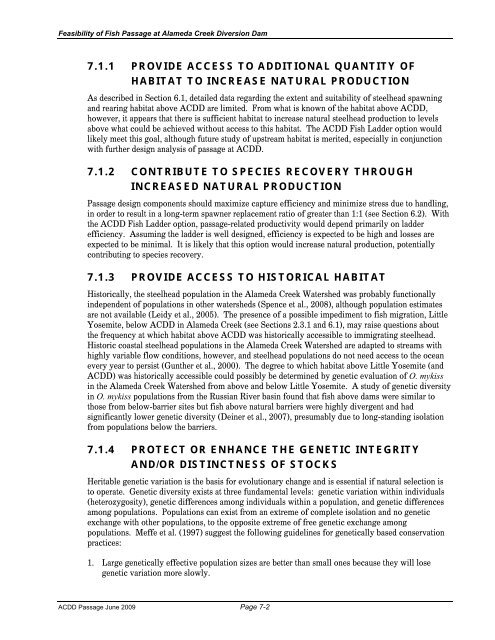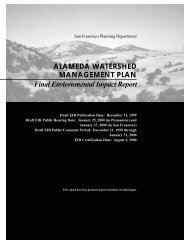Feasibility of Fish Passage at Alameda Creek Diversion Dam
Feasibility of Fish Passage at Alameda Creek Diversion Dam
Feasibility of Fish Passage at Alameda Creek Diversion Dam
Create successful ePaper yourself
Turn your PDF publications into a flip-book with our unique Google optimized e-Paper software.
<strong>Feasibility</strong> <strong>of</strong> <strong>Fish</strong> <strong>Passage</strong> <strong>at</strong> <strong>Alameda</strong> <strong>Creek</strong> <strong>Diversion</strong> <strong>Dam</strong>7.1.1 PROVIDE ACCESS TO ADDITIONAL QUANTITY OFHABITAT TO INCREASE NATURAL PRODUCTIONAs described in Section 6.1, detailed d<strong>at</strong>a regarding the extent and suitability <strong>of</strong> steelhead spawningand rearing habit<strong>at</strong> above ACDD are limited. From wh<strong>at</strong> is known <strong>of</strong> the habit<strong>at</strong> above ACDD,however, it appears th<strong>at</strong> there is sufficient habit<strong>at</strong> to increase n<strong>at</strong>ural steelhead production to levelsabove wh<strong>at</strong> could be achieved without access to this habit<strong>at</strong>. The ACDD <strong>Fish</strong> Ladder option wouldlikely meet this goal, although future study <strong>of</strong> upstream habit<strong>at</strong> is merited, especially in conjunctionwith further design analysis <strong>of</strong> passage <strong>at</strong> ACDD.7.1.2 CONTRIBUTE TO SPECIES RECOVERY THROUGHINCREASED NATURAL PRODUCTION<strong>Passage</strong> design components should maximize capture efficiency and minimize stress due to handling,in order to result in a long-term spawner replacement r<strong>at</strong>io <strong>of</strong> gre<strong>at</strong>er than 1:1 (see Section 6.2). Withthe ACDD <strong>Fish</strong> Ladder option, passage-rel<strong>at</strong>ed productivity would depend primarily on ladderefficiency. Assuming the ladder is well designed, efficiency is expected to be high and losses areexpected to be minimal. It is likely th<strong>at</strong> this option would increase n<strong>at</strong>ural production, potentiallycontributing to species recovery.7.1.3 PROVIDE ACCESS TO HISTORICAL HABITATHistorically, the steelhead popul<strong>at</strong>ion in the <strong>Alameda</strong> <strong>Creek</strong> W<strong>at</strong>ershed was probably functionallyindependent <strong>of</strong> popul<strong>at</strong>ions in other w<strong>at</strong>ersheds (Spence et al., 2008), although popul<strong>at</strong>ion estim<strong>at</strong>esare not available (Leidy et al., 2005). The presence <strong>of</strong> a possible impediment to fish migr<strong>at</strong>ion, LittleYosemite, below ACDD in <strong>Alameda</strong> <strong>Creek</strong> (see Sections 2.3.1 and 6.1), may raise questions aboutthe frequency <strong>at</strong> which habit<strong>at</strong> above ACDD was historically accessible to immigr<strong>at</strong>ing steelhead.Historic coastal steelhead popul<strong>at</strong>ions in the <strong>Alameda</strong> <strong>Creek</strong> W<strong>at</strong>ershed are adapted to streams withhighly variable flow conditions, however, and steelhead popul<strong>at</strong>ions do not need access to the oceanevery year to persist (Gunther et al., 2000). The degree to which habit<strong>at</strong> above Little Yosemite (andACDD) was historically accessible could possibly be determined by genetic evalu<strong>at</strong>ion <strong>of</strong> O. mykissin the <strong>Alameda</strong> <strong>Creek</strong> W<strong>at</strong>ershed from above and below Little Yosemite. A study <strong>of</strong> genetic diversityin O. mykiss popul<strong>at</strong>ions from the Russian River basin found th<strong>at</strong> fish above dams were similar tothose from below-barrier sites but fish above n<strong>at</strong>ural barriers were highly divergent and hadsignificantly lower genetic diversity (Deiner et al., 2007), presumably due to long-standing isol<strong>at</strong>ionfrom popul<strong>at</strong>ions below the barriers.7.1.4 PROTECT OR ENHANCE THE GENETIC INTEGRITYAND/OR DISTINCTNESS OF STOCKSHeritable genetic vari<strong>at</strong>ion is the basis for evolutionary change and is essential if n<strong>at</strong>ural selection isto oper<strong>at</strong>e. Genetic diversity exists <strong>at</strong> three fundamental levels: genetic vari<strong>at</strong>ion within individuals(heterozygosity), genetic differences among individuals within a popul<strong>at</strong>ion, and genetic differencesamong popul<strong>at</strong>ions. Popul<strong>at</strong>ions can exist from an extreme <strong>of</strong> complete isol<strong>at</strong>ion and no geneticexchange with other popul<strong>at</strong>ions, to the opposite extreme <strong>of</strong> free genetic exchange amongpopul<strong>at</strong>ions. Meffe et al. (1997) suggest the following guidelines for genetically based conserv<strong>at</strong>ionpractices:1. Large genetically effective popul<strong>at</strong>ion sizes are better than small ones because they will losegenetic vari<strong>at</strong>ion more slowly.ACDD <strong>Passage</strong> June 2009 Page 7-2








